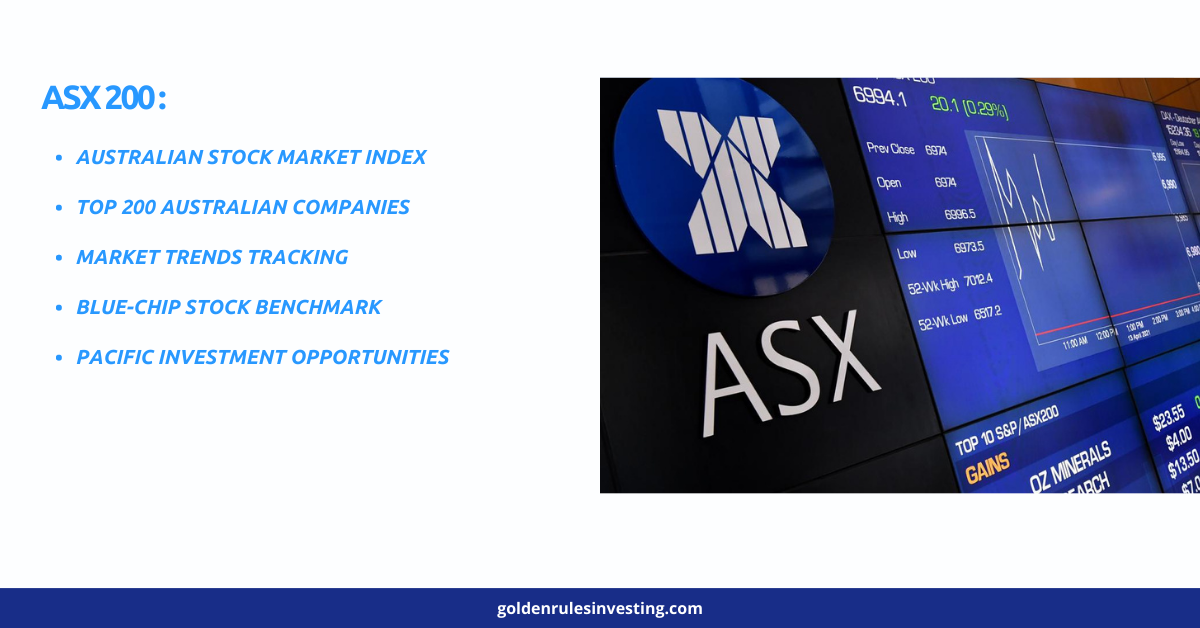
The S&P/ASX 200 (or simply ASX 200) is the most frequently used index of Australia’s Securities Exchange (ASX). ASX 200 is a compilation of the 200-largest public companies based on market capitalisation. This index serves as a benchmark to the Australian market and is comparable to Dow Jones or the FTSE 100 in Britain.
The ASX 200
ASX 200, which tracks the ASX 200 Index’s movements by market capitalisation (market value of outstanding shares) – is one of more than 2000+ companies listed on the ASX. The ASX 200 Australian index is the most closely watched, as it tracks the top 200 companies which account for slightly more that 80%.
The composition of an index is evaluated quarterly. Companies are promoted/demoted based on movement in their share price over six months, as well as other eligibility criteria such liquidity.
What is the ASX 200?
While the ASX 200 spans 10 sectors (including telecommunication, healthcare, industrials), it is dominated primarily by financial and other resources stocks. These stocks account for over half of the ASX 200’s value. The index’s financials sector, which includes the four biggest banks, accounts for close to 30%.
The index is also dominated in part by a handful large companies. More than 40 percent of index members are made up of the 10 largest. The Commonwealth Bank, which is more than 7% of all the index weights as of January 2020 was one of the largest listed companies. The concentration of value in just a few industries and their dominance is something investors should keep in mind when using ASX 200 for a benchmark. This is because movements in banking stocks can have significant impacts on the overall index.
These are the top 10 companies
Commonwealth Bank
BHP Group Limited
CSL Limited
Westpac Banking Corp
National Aust. Bank
ANZ Banking Group
Telstra Corporation
Woolworths Group Limited
Wesfarmers Limited
Macquarie Group Limited
Why is S&P/ASX 200 important
The ASX 200 represents around 80 per cent of Australia’s share market worth $A2 trillion. The ASX 200 provides a useful indicator of Australian economic performance and is therefore a good proxy. It also serves as a benchmark to investors and funds in order for them to compare performance.
How to invest on the ASX 200
While the S&P/ASX 200 has the primary function of being an indicator of Australian market, it can also serve as a useful starting point for investors searching for exposure in large-cap Australian stocks. You can invest in the individual components or by choosing one of these options.
Exchange-traded money
An investor can also purchase an exchange-traded investment fund (ETF). It tracks the ASX 200 in its entirety and trades just like common stock. Investors should review the ASX 200 section makeup before they invest in an ETF. Changes in the financial or materials sectors may have a significant impact on the ETF’s value.
Futures contracts
Standard futures contracts allow people to trade the ASX 200. This is when you agree that you will exchange a quantity or a price of the index to another party at a specified future date.
CFDs
CFDs, also known as Contracts for Different, are similar with Futures Contracts. CFDs offer significant financial leverage and allow investors to borrow most of what they invest in the trade. CFDs don’t have a set price or date in the future, as opposed to Futures. Instead, they can be used as a contract to pay and/or receive the difference in price from the moment the trader initiates the contract until the trader decides to end it. CMC offers CFDs that can be used with a variety of indices such as the ASX 200 or multiple instruments.
Additional Australian indices
Accumulation Index
Noting that the ASX 200 only measures price change is important for speculators (those who bet on the future price of an asset) but doesn’t give investors any information about total returns. The S&P/ASX20 Aggregation Index includes the impact of dividends.
All Ordinarie
Australia’s other market indicator is the All Ordinaries Index. The index measures the 500 largest ASX companies. It differs from ASX 200 in the fact that liquidity isn’t a factor in eligibility. Instead, market capital is the only consideration for companies wanting to be listed.
Others
S&P/ASX 20 Index contains the 20 largest stocks, in terms of market capital, under the same liquidity guidelines than the ASX 200. It is also the most narrow index in the S&P Australian Indices family.
S&P/ASX 300 Index provides greater depth and coverage than S&P/ASX 200 Index. It also maintains liquidity guidelines.
S&P/ASX Emerging Companies Index tracks the performance and ranking of companies that aren’t on the S&P/ASX 300.
Why the ASX 200 should be added to your watchlist
The ASX 200 tracks the performance Australia’s largest businesses and serves as an indicator of the overall market. It is particularly relevant for institutional investors who want to make safer investments.





